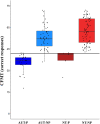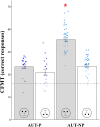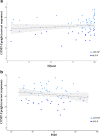Face individual identity recognition: a potential endophenotype in autism
- PMID: 33081830
- PMCID: PMC7576748
- DOI: 10.1186/s13229-020-00371-0
Face individual identity recognition: a potential endophenotype in autism
Abstract
Background: Face individual identity recognition skill is heritable and independent of intellectual ability. Difficulties in face individual identity recognition are present in autistic individuals and their family members and are possibly linked to oxytocin polymorphisms in families with an autistic child. While it is reported that developmental prosopagnosia (i.e., impaired face identity recognition) occurs in 2-3% of the general population, no prosopagnosia prevalence estimate is available for autism. Furthermore, an autism within-group approach has not been reported towards characterizing impaired face memory and to investigate its possible links to social and communication difficulties.
Methods: The present study estimated the prevalence of prosopagnosia in 80 autistic adults with no intellectual disability, investigated its cognitive characteristics and links to autism symptoms' severity, personality traits, and mental state understanding from the eye region by using standardized tests and questionnaires.
Results: More than one third of autistic participants showed prosopagnosia. Their face memory skill was not associated with their symptom's severity, empathy, alexithymia, or general intelligence. Face identity recognition was instead linked to mental state recognition from the eye region only in autistic individuals who had prosopagnosia, and this relationship did not depend on participants' basic face perception skills. Importantly, we found that autistic participants were not aware of their face memory skills.
Limitations: We did not test an epidemiological sample, and additional work is necessary to establish whether these results generalize to the entire autism spectrum.
Conclusions: Impaired face individual identity recognition meets the criteria to be a potential endophenotype in autism. In the future, testing for face memory could be used to stratify autistic individuals into genetically meaningful subgroups and be translatable to autism animal models.
Keywords: Autism; Emotion recognition; Endophenotype; Face memory; Heterogeneity; Individual identity recognition; Prosopagnosia; Social memory; Theory of mind.
Conflict of interest statement
A.P.L. serves on the scientific advisory boards for the Starlab Neuroscience, Neuroelectrics, Neosync, NovaVision, Magstim, and Cognito and is listed as an inventor on several issued and pending patents on the real-time integration of transcranial magnetic stimulation with electroencephalography and magnetic resonance imaging. The other authors declare no competing interests.
Figures




Similar articles
-
Autistic adults have insight into their relative face recognition ability.Sci Rep. 2024 Aug 1;14(1):17802. doi: 10.1038/s41598-024-67649-8. Sci Rep. 2024. PMID: 39090101 Free PMC article.
-
Autistic traits are linked to reduced adaptive coding of face identity and selectively poorer face recognition in men but not women.Neuropsychologia. 2013 Nov;51(13):2702-8. doi: 10.1016/j.neuropsychologia.2013.08.016. Epub 2013 Aug 29. Neuropsychologia. 2013. PMID: 23994355
-
Are people with autism prosopagnosic?Autism Res. 2023 Nov;16(11):2100-2109. doi: 10.1002/aur.3030. Epub 2023 Sep 23. Autism Res. 2023. PMID: 37740564
-
Neural and genetic foundations of face recognition and prosopagnosia.J Neuropsychol. 2008 Mar;2(1):79-97. doi: 10.1348/174866407x231001. J Neuropsychol. 2008. PMID: 19334306 Review.
-
Face identity recognition in autism spectrum disorders: a review of behavioral studies.Neurosci Biobehav Rev. 2012 Mar;36(3):1060-84. doi: 10.1016/j.neubiorev.2011.12.008. Epub 2011 Dec 23. Neurosci Biobehav Rev. 2012. PMID: 22212588 Review.
Cited by
-
Social Interaction Anxiety in Developmental Prosopagnosia: Prevalence, Severity, and Individual Differences.Arch Clin Neuropsychol. 2025 Apr 27;40(3):409-424. doi: 10.1093/arclin/acae074. Arch Clin Neuropsychol. 2025. PMID: 39348824
-
Prosopagnosia is highly comorbid in individuals with probable developmental coordination disorder.Q J Exp Psychol (Hove). 2025 Aug;78(8):1501-1522. doi: 10.1177/17470218241275977. Epub 2024 Aug 13. Q J Exp Psychol (Hove). 2025. PMID: 39138399 Free PMC article.
-
Neural correlates of facial recognition deficits in autism spectrum disorder: a comprehensive review.Front Psychiatry. 2025 Jan 6;15:1464142. doi: 10.3389/fpsyt.2024.1464142. eCollection 2024. Front Psychiatry. 2025. PMID: 39834575 Free PMC article. Review.
-
Autistic adults have insight into their relative face recognition ability.Sci Rep. 2024 Aug 1;14(1):17802. doi: 10.1038/s41598-024-67649-8. Sci Rep. 2024. PMID: 39090101 Free PMC article.
-
Contributions of face processing, social anhedonia and mentalizing to the expression of social autistic-like traits.Front Behav Neurosci. 2022 Dec 22;16:1046097. doi: 10.3389/fnbeh.2022.1046097. eCollection 2022. Front Behav Neurosci. 2022. PMID: 36620857 Free PMC article.
References
-
- American Psychiatric Association. Diagnostic and statistical manual of mental disorders : DSM-5. Fifth edition. Arlington: American Psychiatric Association, [2013]; 2013. Available from: https://search.library.wisc.edu/catalog/9910187853902121.
-
- Lai M, Lombardo MV, Baron-Cohen S. Autism. Lancet. 2013;6736(13):1–15.
-
- Lai MC, Lombardo MV, Auyeung B, Chakrabarti B, Baron-Cohen S. Sex/Gender Differences and autism: setting the scene for future research. Journal of the American Academy of Child and Adolescent Psychiatry. 2015;54:11–24 Available from: https://linkinghub.elsevier.com/retrieve/pii/S0890856714007254. - PMC - PubMed
Publication types
MeSH terms
Grants and funding
LinkOut - more resources
Full Text Sources

